Krebs Shares Vision for Improving Pain Management

Photo: Marleen Van Den Neste
When faced with chronic pain, many patients and health care providers may not know about treatment possibilities beyond the standard drugs, or the evidence on them. Against the backdrop of the current opioid epidemic, NCCIH recently sponsored a lecture by Dr. Erin Krebs on ways to improve pain management in primary care. The event was part of the center’s Integrative Medicine Research Lecture Series.
“Two of our top scientific priorities at NCCIH are to improve understanding of pain and identify effective complementary and integrative health approaches to improve, treat and manage pain—the number one reason Americans turn to these approaches,” said Dr. David Shurtleff, NCCIH acting director. “Pain is front and center in the opioid crisis. There is much to learn about how to best optimize pain management and reduce reliance on opioid medications.”
Krebs, who is associate professor of medicine at the University of Minnesota, an internist and health services researcher at the Minneapolis VA Health Care System and an NCCIH grantee, discussed “reframing” pain management in primary care. Clinicians in this specialty have a key role in caring for patients experiencing chronic pain, but face barriers in doing so—from being overburdened to working in health systems not designed or equipped to manage chronic pain. Other challenges include health problems that often co-occur with chronic pain (such as depression, anxiety disorders, insomnia and substance abuse) and the fact that, as Krebs put it, “Our whole way of thinking about pain care has become very opioid-centered.

Photo: Marleen Van Den Neste
“Bottom line: We just don’t know as much as we need to know about opioids,” she continued. “What we do know suggests that they don’t deserve this central role…which has taken a toll on patients, primary care and pain management.” One glint of light in the opioid crisis, she said, is that “we have an opportunity to think about pain management and how to do it differently.”
Krebs’s recommendations on reframing pain management grew out of several concepts in HHS’s National Pain Strategy. “Pain care should be patient-centered, accounting for individual preferences, risks and social contexts; comprehensive, meeting patients’ biopsychosocial needs; and multimodal and integrated, using evidence-based treatments,” she said.
A strong finding from her research is that “patients really want physicians and clinicians to hear them, listen to them and understand their pain experience.” Patients “do not think about pain in isolation” and do not simply want pain relief, but also improvements in specific aspects of their daily lives. Providers need to discuss the topic of pain with their patients, she said, but often don’t know how to bring this up or what to say. She recommended that providers become informed about nondrug treatment options; use a multimodal approach to address the full range of biological, psychological and social factors operating in pain; and have a coordinated treatment plan. “Just because someone does a lot of [modalities] doesn’t necessarily mean they’re getting multimodal care—it may be pretty disconnected,” she cautioned.
Krebs shared evidence-based recommendations on nondrug therapies that emerged from a 2016 VA state-of-the-art conference she co-chaired on nonpharmacologic approaches for musculoskeletal pain. The convened experts were charged with assessing the evidence and identifying therapies for multimodal treatment of musculoskeletal pain that could be implemented broadly and quickly in the Veterans Health Administration system. Nine therapies showed “sufficient” evidence: acupuncture, manipulation, massage, exercise, tai chi, yoga, acceptance and commitment therapy, cognitive behavioral therapy and mindfulness-based stress reduction. All, however, had shown small- to medium-sized benefits and worked for fewer than half of the study participants who tried them.
“No one treatment is best for all people,” Krebs said. “This isn’t surprising, given what we know about the complexity of chronic pain.” Patient and provider expectations regarding chronic pain and any therapy being considered thus require attention.
Krebs compared “passive” nondrug therapies (i.e., those delivered by a practitioner) with “active” ones (i.e., those patients engage with themselves) and concluded that “a combination of both types may be best.” The lecture is available at https://videocast.nih.gov/launch.asp?23840. NCCIH’s portal of information on chronic pain is at https://nccih.nih.gov/health/pain.
